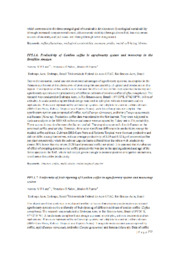Uniformity of fruit ripening of Conilon coffee in agroforestry system and monocrop system.
Uniformity of fruit ripening of Conilon coffee in agroforestry system and monocrop system.
Autoria: LUNZ, A. M. P.; SALES, F. de; MESQUITA, J. F. B. de
Resumo: The objective of this work was to evaluate the effect of two coffee cropping systems (monocrop and agroforestry system) on the uniformity of fruit ripening of different cultivars of conilon coffee (Coffea canephora). The research was conducted at Embrapa Acre, in Rio Branco-Acre, Brazil (10º1'30"S, 67º42'18"W). A randomized complete block design was used in split plot, with six treatments and six replications. Plots were represented by coffee crop systems and subplots by conilon coffee cultivars (BRS-Ouro Preto, Robusta Tropical and Espirito Santo). The agroforestry system was composed by coffee, açaí (Euterpe oleraceae), andiroba (Carapa guianensis) and banana (Musa sp). Data of coffee ripening were collected in the first harvest. At the first harvest of coffee, sample of 200g of coffee fruits were removed each plot and quantified by counting of the unripe, ripe (cherry) and dry fruit. Subsequently was calculated the proportion of coffee fruits at each maturation stage. The ripening stage of coffee fruits was different in the two cropping systems. There was a slight improvement in uniformity of fruit ripening from the agroforestry system. Fruits of coffee plants in monocrop, in other words under full solar radiation, showed maturity stage advanced than the fruits from agroforestry system, which were shaded. In the monocrop there was a higher percentage of dry fruits (40%) and a smaller fraction of green fruits (19%), while the opposite occurred in the agroforestry system, where only 20% of the fruits were dried and 29% green. The percentage of mature fruits was 41 and 51% in monoculture and agroforestry systems, respectively. The coffee cultivars showed similar behavior. All cultivars had 37% of dry fruits. Vitoria and Espírito Santo cultivars showed 24% of green fruits and BRS Ouro Preto 25%. The percentage of ripe fruit was 31% in BRS-Ouro Preto and 37% in other.
Ano de publicação: 2014
Tipo de publicação: Resumo em anais e proceedings
Unidade: Embrapa Acre
Palavras-chave: Amadurecimento do fruto, Café conilon, Rio Branco (AC), Sistema de monocultivo, Sistemas agroflorestais
Observações
1 - Por padrão são exibidas publicações dos últimos 20 anos. Para encontrar publicações mais antigas, configure o filtro ano de publicação, colocando o ano a partir do qual você deseja encontrar publicações. O filtro está na coluna da esquerda na busca acima.
2 - Para ler algumas publicações da Embrapa (apenas as que estão em formato ePub), é necessário ter, no celular ou computador, um desses softwares gratuitos. Sistemas Android: Google Play Livros; IOS: iBooks; Windows e Linux: software Calibre.
Acesse outras publicações
Acesse a Base de Dados da Pesquisa Agropecuária (BDPA) para consultar o acervo completo das bibliotecas da Embrapa.

